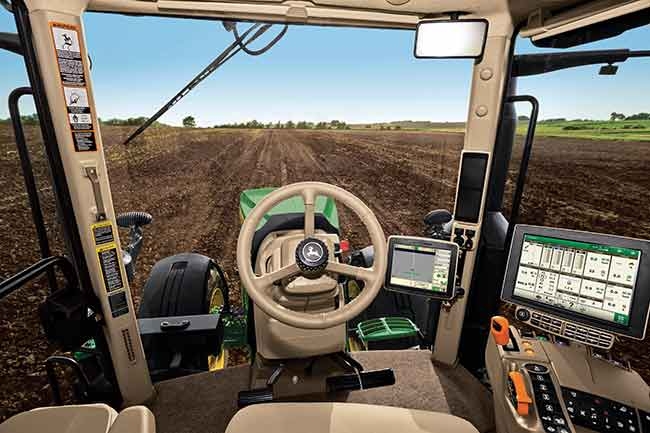
Precision Ag
Defining precision agriculture
Modern farm equipment, GPS and computers have enabled precision agriculture to easily prescribe seamless rate changes for almost any crop input. Satellite remote sensing can detect vegetation differences and compare the in-season vegetation to the past seasons’ vegetation. UAVs/drones are available to see your fields with a bird’s-eye view. During harvest, combines measure yield results every one to three seconds to enable accurate analysis and mapping. Grain charts can record the bushels and you can count the truckloads to verify final yields. Advanced bin monitoring ensures grain is stored securely to manage moisture and quality. Farmers can assess the results of any on-farm comparisons/check-strips to review all management decisions given the particular weather conditions for the growing season. The convergence of technologies is happening very quickly in agriculture.
Farmers are always trying new things and relying on their experiences to anticipate the weather and conditions to succeed. With or without accurate measurement, farmers will always judge if something worked or not. Historically, government agriculture research and industry professionals relied on solid efficacy data to promote their products and the retail channel had strong relationships with farmers. This combination of elements is what made the Canadian farmers so good.
All farmers practice precision agriculture to some degree. For instance, when you disc excess moisture spots in the field – that is site-specific crop management. During a supper dialogue, you realize that one spot was missed but you don’t want to go back for it. This becomes your check-strip comparison. But you don’t really plan to measure yields next year between the disced vs. non-disced areas. You don’t have an easy mechanism to track and measure this comparison. You already know that removing the ruts is worth it, based on your experience.
There are a lot of skeptics when it comes to variable rate technology (VRT). VRT started over a decade ago before the tools were available to easily measure results. VRT has proven it works well (when done correctly) in fields with variability. All fields have some degree of variability which shows on the combine yield monitors and in the vegetation differences visible from the sky.
Consider that most farmers and agronomists can’t answer relatively simple questions like: What was the best canola variety? How many more bushels per acre did the fungicide application provide? What was the correct rate of nitrogen that produced the highest economic return in the canola or wheat? What was the correct seeding rate? Part of the reason these questions are difficult to answer is that the correct answer varies by region for the soil characteristics and climatic conditions of that season. There are many complex factors and interactions that influence final crop yields. Anyone can have an educated guess, but all scientific research starts with a hypothesis framed as “If I do this, then this will happen.”
Observation and measurement is required to prove your hypothesis. If someone claims to be an expert, ask that person to accurately predict your crop yield prior to harvest. How well did anyone predict your yields over the past five years?
Virtually all product research conducted by companies consists of small-plot trials to minimize field variability and enable statistical analysis. Later in the process, larger strip trials use real farm equipment to assess real world conditions. Multiple sites are required across a wide area, and it is rare for any treatment to win every time. Was it the product treatment, or does that area on the left side always out-yield the right side of the field? Most farmers acknowledge the limitations to small-plots and strip-trial formats, but those are the standards for the industry. Prior to 2012, the Pest Management Regulatory Agency (PMRA) required efficacy data for product registrations, but now the Canadian marketplace is buyer beware, as the U.S. has always been. The reality is that little on-farm research is conducted and few farmers leave check-strips or comparisons within a field. Most farmers don’t have the time or tools to accurately measure yield and review results.
For those of you with perfectly uniform fields on your farm, precision agriculture can enable you to compare differences in product performance, and you can get paid to generate the data and yield results to go beyond hollow testimonials.
The main challenge to precision agriculture is the lack of knowledgeable people in this technology segment. There is a general shortage of young folk now that farmers comprise one per cent of the population, and no Canadian schools have degrees or diplomas in precision agriculture. Many experienced/mature farmers have no idea what the technology is capable of nor how to use it on the farm.
Even with current challenges, most farmers agree they will adopt precision agriculture in the future, but they have difficulty articulating what exactly it will look like. The beauty of technology is that it can transform what was once difficult or impossible into something that happens every day.
Dale Steele is a precision agronomist in southern Alberta. “Precision agronomist” is a fairly new term that includes geospatial technologies like GIS, GPS and remote sensing/imagery in traditional agriculture management activities. Dale always tries to see things from a farmer’s perspective, to ensure new technology is relevant to the farm.
December 2, 2015 By Dale Steele P.Ag. Precision Agronomist
 Modern farm equipment Modern farm equipment
Modern farm equipment Modern farm equipment